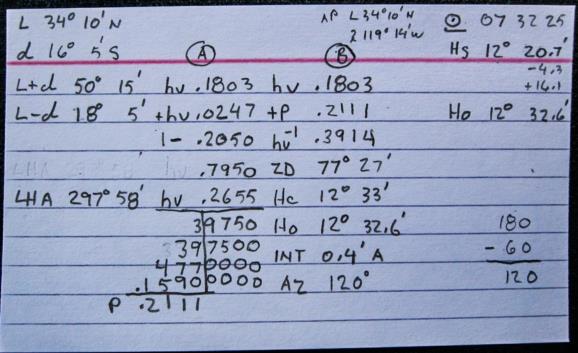
NavList:
A Community Devoted to the Preservation and Practice of Celestial Navigation and Other Methods of Traditional Wayfinding
From: Greg Rudzinski
Date: 2014 Nov 6, 08:21 -0800
Hanno,
This morning I test drove the haversine table only Doniol longhand reduction (Ix variant). There are two extra sums. The 1-sum and converting zenith distance to Hc. The single product is simplified by a digit and the product haversine sum is an addition vs. subtraction.
The benefit of only needing the haversine table is worth the extra summing. If this isn't the best longhand sight reduction method then it is very close to it. See the attached RIC.
Double Bravo !! Hanno
Greg Rudzinski
From: Hanno Ix
Date: 2014 Nov 5, 20:28 -0800
Greg,
there might be an opportunity for another RIC!
Doniol can be re-written such that only one table is needed - the haversine table. There is one condition, though, that requires adopting "s2s" in stead of Hc: s2s is my abbreviation for "Star to Ship" or "Ship to Star" meaning the spherical distance between the ship's location and the substellar point. We know that sin(Hc) = cos(s2s). Now, I can show to you that Doniol assumes the following form which uses only a single trig function if one adopts this s2s convention:
hav(s2s) = hav(L-d) - [ hav(L-d) + hav(L+d) - 1 ]* hav(LHA).
I don't need to stress the great advantages of the haversine - they are all well known. These advantages plus the reduction of the number of tables to one, the haversine table, will justify the proposed change of convention from Hc to s2s I think. s2s has the additional nicety that "smaller" means "closer" - a welcome fact for teaching and memorizing. You know, I always found it peculiar that one explains CelNav by drawing circles on the globe but ends up not using their radius in actual work. The additional complexity of teaching “higher” is “closer” is a cumbersome but unnecessary detour and just a matter of tradition.







